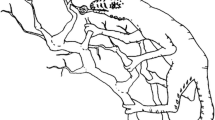Abstract
What is the relation between material hermeneutics, bodies, perception and materials? In this article, I shall argue cultural learning processes tie them together. Three aspects of learning can be identified in cultural learning processes. First, all learning is tied to cultural practices. Second, all learning in cultural practice entangle humans’ ability to recognize a material world conceptually, and finally the boundaries of objects, the object we perceive, are set by shifting material-conceptual entanglements. All these aspects are important for material hermeneutics in a technoculture. Postphenomenology has expanded the connection between hermeneutics and phenomenology by focusing on studies of how perception, bodies, materials, the sensual realm and hermeneutics are entwined when we perceive the world through technologies. Following Don Ihde, hermeneutics expands beyond interpretation of texts in the humanities. We can interpret materials as for instance animal bones to make new sense of the Bible. New technologies have expanded material hermeneutics, when we can ‘look’ into bodies and ‘perceive’ below surfaces. Interpretation via such tools in a technoculture, both limit and extend our hermeneutic horizons in the humanities as well as in the natural sciences. Furthermore, from the perspective of cultural learning processes, material hermeneutics in the human and natural sciences depend on more than mediating instruments. Material hermeneutics also involve the material cultural environments of scientific apparatuses and the scientists’ processes of learning in cultural practice. This changes the focus from relations in postphenomenology to processes of relations.
Similar content being viewed by others
Change history
20 November 2023
A Correction to this paper has been published: https://doi.org/10.1007/s00146-023-01816-9
Notes
If, and this is very likely, my rendering of the Stern-Gerlach experiment is somewhat flawed, this only proves the point made in this article—not being a physicist, I have limited access to draw on the cultural resources of physicists and thus thoroughly understand the cultural practice of particle physics, both now as well as in the 1920s.
Alternatively, hear, as when they hear sounds identified as whale songs (Ihde 2007).
Ihde has also early on expanded the visual hermeneutics to include other kinds of perception, e.g. sound (Ihde 2007), but for my purpose, visual hermeneutics will do.
References
Barad K (2007) Meeting the universe halfway: quantum physics and the entanglement of matter and meaning. Duke University Press, Durham
Friedrich B, Herschbach D (2003) Stern and Gerlach: how a bad cigar helped reorient atomic physics. Phys Today 56(12):53–59. https://doi.org/10.1063/1.1650229
Friis JKBO (2012) Perception: embodiment and beyond. Found Sci 17:363–367. https://doi.org/10.1007/s10699-011-9242-y
Hasse C (2008) Postphenomenology: learning cultural perception in science. Hum Stud 31(1):43–61. https://doi.org/10.1007/s10746-007-9075-4
Hasse C (2015) An Anthropology of learning. Springer Verlag, Dordrecht
Hasse C (2018) Studying the telescopes of others: towards a postphenomenological methodology of participant observation. In: Aagaard J, Friis JKB, Sorenson J, Tafdrup O, Hasse C (eds) Postphenomenological methodologies: new ways in mediating techno-human relationships. Lexington Books, Lanham, pp 241–259
Hasse C (2019) Posthuman learning: AI from novice to expert? AI Soc 34:355–364. https://doi.org/10.1007/s00146-018-0854-4
Hasse C (2020) Posthumanist learning: What robots and cyborgs teach us about being ultra-social. Routledge, London
Heelan PA (1972) Nature and its transformations. Theol Stud XXXIII 33(3):486–502. https://doi.org/10.1177/004056397203300307
Ihde D (1980) Interpreting hermeneutics: origins, developments and prospects. Man and World 13:325–343. https://doi.org/10.1007/BF01252551
Ihde D (1990) Technology and the lifeworld (the Indiana series in the philosophy of technology). Indiana University Press, Bloomington
Ihde D (1998) Expanding hermeneutics: visualism in science. Northwestern University Press, Evanston
Ihde D (2005) More Material Hermeneutics. Yearbook of the institute for advanced studies on science, technology and society. Profil Verlag, Munich/Vienna, pp 341–350
Ihde D (2007) Listening and voice. Phenomenologies of sound, 2nd edn. SUNY Press, New York
Ihde D (2009) Postphenomenology and Technoscience: The Peking University Lectures. SUNY Press, New York
Rosenberger R (2014) Multistability and the agency of mundane artifacts: from speed bumps to subway benches. Hum Stud 37(1):369–392. https://doi.org/10.1007/s10746-014-9317-1
Rosenberger R (2017) On the hermeneutics of everyday things: or, the philosophy of fire hydrants. AI Soc 32:233–241. https://doi.org/10.1007/s00146-016-0674-3
Scharff RC (2020) When is a phenomenologist being hermeneutical? AI Soc. https://doi.org/10.1007/s00146-020-00990-4 (Pre-print Retrieved May 28th 2020)
Stern O (1946) The Method of Molecular Rays. Nobel Lecture. In: Les Prix Nobel en 1946, ed. by M. P. A. L. Hallstrom et al. Stockholm, Imprimerie. Royale [Retrieved 24 May 2020]. 123–30. https://www.nobelprize.org/prizes/physics/1943/stern/lecture/
Tripathi AK (2015) Postphenomenological investigations of technological experience. AI Soc 30:199–205. https://doi.org/10.1007/s00146-014-0575-2
Tripathi AK (2017) Hermeneutics of technological culture. AI Soc 32(2):137–148. https://doi.org/10.1007/s00146-017-0717-4
Tripathi AK (2018) Technological mediation and sociocultural variability. In: Aagaard J, Friis JKB, Sorensen J, Tafdrup O, Hasse C (eds) Postphenomenological methodologies: new ways in mediating techno-human relationships. Lexington Books, Lanham, pp 217–239
Verbeek PP (2003) Material Hermeneutics (Review of Ihde, D. 1998 ‘Expanding Hermeneutics: Visualism in Science’). Techné. 6(3):181–184. https://doi.org/10.5840/techne20036325
Weinert F (1995) Wrong theory—Right experiment: the significance of the Stern-Gerlach experiments. Stud Hist Phil Mod Phys 26(1):75–86. https://doi.org/10.1016/1355-2198(95)00002-B
Author information
Authors and Affiliations
Corresponding author
Additional information
Publisher's Note
Springer Nature remains neutral with regard to jurisdictional claims in published maps and institutional affiliations.
Rights and permissions
Springer Nature or its licensor (e.g. a society or other partner) holds exclusive rights to this article under a publishing agreement with the author(s) or other rightsholder(s); author self-archiving of the accepted manuscript version of this article is solely governed by the terms of such publishing agreement and applicable law.
About this article
Cite this article
Hasse, C. Material hermeneutics as cultural learning: from relations to processes of relations. AI & Soc 38, 2037–2044 (2023). https://doi.org/10.1007/s00146-021-01171-7
Received:
Accepted:
Published:
Issue Date:
DOI: https://doi.org/10.1007/s00146-021-01171-7




